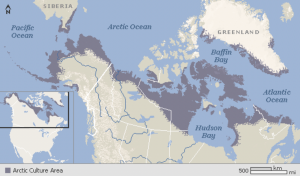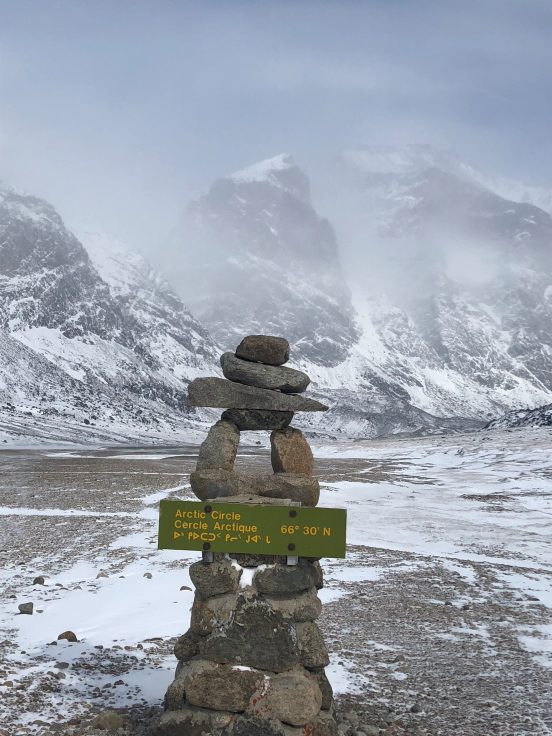Photo by Isaac Demeester on Unsplash
By Kyara Liu
As defined by the United Nation’s Human Rights Council, the right to food is “the right to have regular, permanent and unrestricted access… to adequate and sufficient food corresponding to the cultural traditions of the people to which the consumer belongs, and which ensure a physical and mental, individual and collective, fulfilling and dignified life free of fear.” [1] In 2018, 4.4 million Canadians and 1.2 million children under 18 experienced some level of food insecurity, equating to about 13% of the population, with 28.2% of these households identifying as Indigenous. [2] Additionally, the Arctic provinces and territories of Nunavut, Northwest Territories (NWT) and Yukon overwhelmingly have the highest levels of food insecurity, as well as having a much higher proportion of Indigenous peoples in relation to other areas of Canada. [2], [3]

Figure 1. Household food insecurity by province and territory. Retrieved from https://proof.utoronto.ca/wp-content/uploads/2020/03/Household-Food-Insecurity-in-Canada-2017-2018-Full-Reportpdf.pdf
The Canadian Arctic is home to diverse groups of Indigenous peoples native to the land. The Inuit and Inuvialuit, or known collectively as the Inuit Nunangat (the Inuktitut phrase for land, water, and ice) reside in their territories in the Arctic. Other groups include the Gwich’in in the Yukon and Northwest Territories, the Innu in Labrador, and the Cree in Hudson’s Bay. [4] This article will focus on food insecurity as the lack of access to food, as well as the lack of access to culturally significant foods and how Indigenous populations are being affected with consideration to climate change.

Figure 2. The geographical area of The Arctic. Retrieved from https://www.pewtrusts.org/en/projects/conserving-life-in-canadas-oceans/northern-communities
Canada’s legacy of colonialism and racism continues to negatively impact Indigenous populations, especially in the north. From the forced migration of these groups on to resource-scarce reserves, to bans on hunting animals essential for their survival; Indigenous populations in northern Canada have been denied their autonomy, income and important aspects of their culture. [5]
Read more: Colonialism created food insecurity in the Arctic
Climate change is a threat to natural food systems
The events of extreme weather as a result of climate change, such as melting sea ice, flooding, erosion and ecosystem disruption are emergently affecting northern, rural residents. This issue is also associated with the high levels of household food insecurity in these areas. This is because a households’ vulnerability is a function of their capacity to avoid or weather negative income shocks which has been harder and harder to navigate as these events have increased in severity and frequency. [6], [7] Furthermore, the changing climate has had a severe impact on the natural food systems in the north. As a result, Indigenous populations in the Arctic who rely on hunting as a means of food have been severely affected. Global warming has resulted in the melting and thinning of the ice in Northern Canada, which thus impacts the migratory patterns of certain animals, as well as the ability to utilize the ice as tool to hunt; something that these populations rely on to feed themselves [8]. Additionally, to these groups, their use of land goes beyond finding food; it is also a reflection of their deep connection to the land of their ancestors and its importance to their cultural identity and traditions. [8] For example, the Uqsuqtuurmiut (people of Uqsuqtuuq in Gjoa Haven, Nunavet) practice their knowledge and culture with people; animals; as well as the land, water and sea ice as a connection to physical and emotional wellbeing. [9] This is expressed as their happiness inherent to being ‘on the land.’ [9] As such, the effects of the changing climate and land has had a deeper and more detrimental effect on these populations physically, mentally and spiritually.
Compounded with land loss and food access challenges, a food desert exists in much of rural northern Canada. Food deserts are defined as geographical areas where healthy foods (such as fresh fruits and vegetables) are either not available or out of the community’s financial ability to afford. [10] With hunting restrictions and the effects of climate change on natural food systems, Indigenous populations are limited to purchasing food that is imported to their remote area; food that is inaccessible, unaffordable and unhealthy. [8] Their remote location means that food must be flown in and as such, fresh produce is usually the first to go bad. [11] As a result, unhealthy processed food is what remains as the only option. The high intake of these types of foods result in health outcomes such as micronutrient deficiencies and obesity. [10], [12]

Figure 3. Photo from THE CANADIAN PRESS/Sean Kilpatrick. Retrieved from https://intercontinentalcry.org/rocket-debris-risk-inuit-food-security/
The pressing issues around food insecurity in the north highlight the need for action and further research. There are many macro level responses that can be taken to mitigate the severity of this situation. Climate change is a serious and emergent problem that needs the attention and action of institutions, policy makers and individuals. Due to their cultural traditions and closeness to the land, Indigenous people are more likely to have feelings of solastalgia, which is “the distress that is produced by environmental change impacting on people while they are directly connected to their home environment” and other mental health concerns from the loss of traditional practices involving their use of the land. [13]
Watch: Price check: Why are grocery prices in Canada’s North so high?
What needs to be done?
Food security need to be addressed on the meso and macro level. The Canadian government implemented Nutrition North Canada, a program that “helps make nutritious food and some essential items more affordable and more accessible.” [14] However, program evaluations have criticized it for the lack of price caps or other means of ensuring food is affordable and equitably priced in communities and gaps in food cost reporting constrain the program’s accountability. [15] Furthermore, it has also been critiqued in that it discourages food sovereignty and fails to find innovative ways to help northern communities operate more independently. [16]
The Eat Think Vote campaign calls for food sovereignty for Indigenous people, a term encompassing that is the right of peoples to healthy and culturally appropriate food produced through ecologically sound and sustainable methods. [17] This includes calls to the government to:
- Develop a national food policy that includes the northern context, and the recognition of the right to food for Indigenous Peoples in Canada. This policy should:
- Be developed by engaging with Indigenous communities and leaders in regards to policy changes that would produce the most effective impact
- Draw attention to Indigenous perspectives on food and community-led food security [18]
- Provide sustainable funding for Community Food Coordinators in all northern communities, as a mechanism to both act at the local level and inform policy.
- Establish a basic income floor adjusted to reflect northern costs.
Government programs creating food subsidies are vital, but cannot stand as the only solution to ending food insecurity in the north. Food sovereignty has been a concept that is stressed in the literature as a method to not only return parts of their stolen culture back to northern Indigenous populations, but also to subsidize the reliance these groups have on expensive imported foods from grocery stores. The Inuit and other Indigenous groups in the north have survived for centuries on their lands despite the harsh climates, through sustainable food practices. As such, self-determination needs to be given to these groups so that they can “respond to their own needs for healthy, culturally adapted Inuit foods.” [18]
Prioritizing and uplifting the voices of Indigenous leaders and communities are vital when considering policy changes regarding climate change and food insecurity. We need to shift our understanding of Indigenous knowledge systems as a way of living. Indigenous scholar and environmentalist Deborah McGregor summarizes that, “one cannot ever really “acquire” or “learn” Indigenous knowledge without having undergone similar experiences to those originally involved in acquiring/generating, holding, and transmitting such knowledge.” [19] This highlights the need for decolonizing the current discourses around climate change to fight the climate and food security crises in the Canadian Arctic.
Taking Action
Further Learning Resources
Human Rights Watch – Climate change and Indigenous right to food
Food Secure Canada – Affordable food in the north
Tackling Food Insecurity in Canada
Indigenous Food Sovereignty Video
The Truth and Reconciliation Commission 94 Calls to Action
Works Cited
[1] United Nations, “OHCHR | AboutHRFood,” 2014. https://www.ohchr.org/EN/Issues/Food/Pages/AboutHRFood.aspx (accessed Nov. 17, 2021).
[2] V. Tarasuk and A. Mitchell, “Household Food Insecurity in Canada:,” Top. Clin. Nutr., vol. 20, no. 4, pp. 299–312, 2020, doi: 10.1097/00008486-200510000-00003.
[3] Statistics Canada, “Aboriginal Peoples in Canada: First Nations People, Métis and Inuit,” 2018. https://www12.statcan.gc.ca/nhs-enm/2011/as-sa/99-011-x/99-011-x2011001-eng.cfm (accessed Nov. 17, 2021).
[4] “Northern Communities.” https://pew.org/1zfr2kO (accessed Dec. 01, 2021).
[5] J. Snook et al., “‘We’re Made Criminals Just to Eat off the Land’: Colonial Wildlife Management and Repercussions on Inuit Well-Being,” Sustainability, vol. 12, no. 19, p. 8177, 2020, doi: http://dx.doi.org/10.3390/su12198177.
[6] T. Battis and C. Somos, “‘We are living it already’: Climate change behind extreme weather events in Canada, experts say,” CTVNews, Jul. 02, 2021. https://www.ctvnews.ca/climate-and-environment/we-are-living-it-already-climate-change-behind-extreme-weather-events-in-canada-experts-say-1.5495229 (accessed Nov. 15, 2021).
[7] V. Tarasuk, A.-A. Fafard St-Germain, and A. Mitchell, “Geographic and socio-demographic predictors of household food insecurity in Canada, 2011–12,” BMC Public Health, vol. 19, no. 1, p. 12, Jan. 2019, doi: 10.1186/s12889-018-6344-2.
[8] K. Rall, R. LaFortune, L. Tellez-Chavez, C. McLeod, and I. Gazendam, “‘My Fear is Losing Everything’: The Climate Crisis and First Nations’ Right to Food in Canada,” Human Rights Watch, Oct. 2020. Accessed: Nov. 15, 2021. [Online]. Available: https://www.hrw.org/report/2020/10/21/my-fear-losing-everything/climate-crisis-and-first-nations-right-food-canada
[9] S. Robertson and G. Ljubicic, “Nunamii’luni quvianaqtuq (It is a happy moment to be on the land): Feelings, freedom and the spatial political ontology of well-being in Gjoa Haven and Tikiranajuk, Nunavut,” Environ. Plan. Soc. Space, vol. 37, no. 3, pp. 542–560, Jun. 2019, doi: 10.1177/0263775818821129.
[10] J. Shannon, “Food deserts: Governing obesity in the neoliberal city,” Prog. Hum. Geogr., vol. 38, no. 2, pp. 248–266, Apr. 2014, doi: http://dx.doi.org/10.1177/0309132513484378.
[11] L. Cecco, “The food desert of the north,” Al Jazeera America, 2015. http://projects.aljazeera.com/2015/12/nunavut-food-insecurity/ (accessed Nov. 17, 2021).
[12] T.-A. Kenny, X. F. Hu, J. A. Jamieson, H. V. Kuhnlein, S. D. Wesche, and H. M. Chan, “Potential impact of restricted caribou (Rangifer tarandus) consumption on anemia prevalence among Inuit adults in northern Canada,” BMC Nutr., vol. 5, no. 1, p. 30, May 2019, doi: 10.1186/s40795-019-0292-9.
[13] G. Albrecht et al., “Solastalgia: The Distress Caused by Environmental Change,” Australas. Psychiatry, vol. 15, no. 1_suppl, pp. S95–S98, Feb. 2007, doi: 10.1080/10398560701701288.
[14] G. of C. N. N. Canada, “How Nutrition North Canada works,” Nov. 09, 2014. https://www.nutritionnorthcanada.gc.ca/eng/1415538638170/1415538670874 (accessed Nov. 23, 2021).
[15] T. Galloway, “Canada’s northern food subsidy Nutrition North Canada: a comprehensive program evaluation,” Int. J. Circumpolar Health, vol. 76, no. 1, p. 1279451, 2017, doi: 10.1080/22423982.2017.1279451.
[16] T. Robinson, “Nutrition North Canada and the Fight Against Food Insecurity,” McGill Journal of Political Studies, Feb. 16, 2021. http://mjps.ssmu.ca/2021/02/15/nutrition-north-canada-and-the-fight-against-food-insecurity/ (accessed Nov. 24, 2021).
[17] H. Whitman and A. Aurélie Desmarais, “Food Sovereignty In Canada,” Canadian Centre for Policy Alternatives, 2012. https://www.policyalternatives.ca/publications/monitor/food-sovereignty-canada (accessed Nov. 24, 2021).
[18] R. Datta, “Community-led food resilience:A decolonizing autographic learning from an Inuit community,” Glob. Food Secur., vol. 30, p. 100564, Sep. 2021, doi: 10.1016/j.gfs.2021.100564.
[19] D. McGregor, “Indigenous Knowledge Systems in Environmental Governance in Canada,” KULA Knowl. Creat. Dissem. Preserv. Stud., vol. 5, no. 1, Art. no. 1, Jun. 2021, doi: 10.18357/kula.148.
